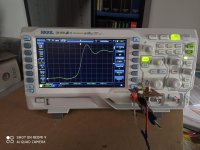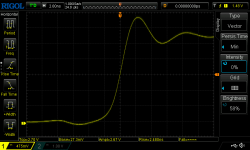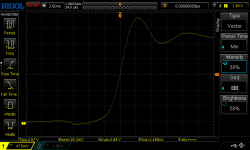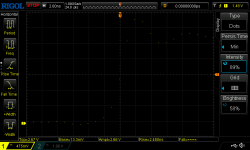Siglent SDS1104X-E is on sale @Amazon $417, which looks like a good deal.
How about Siglent signal generator? I do have to buy both SDS1000X-E-FG firmware key AND the SAG1021 generator to make them work, right?
Yes, but the firmware option and the belonging SAG1021 is in my opinion expensive and doesn't have much advantage to a standalone generator. It is smaller of course, but you still have the same cable clutter on your desk. All Siglent standalone signal generators can communicate over USB with their oscilloscopes when doing Bode plot for instance, but you can't use the oscilloscope menus to program them, like you can do with the SAG1021. I much prefer real buttons, though.
I opted for a separate Siglent signal generator. In hindsight I was cheap and bought the cheapest one channel generator. When doing Bode plot you need two signals. It can be done with a T piece from one channel, but could be of advantage to have a two channel generator in other use cases.
Last edited:
I wonder what Siglent can do which Digilent can't do for audio frequency range work.
I can't say for sure, because I don't have experience, but this is what I have understood. Basically a traditional oscilloscope is not a precision instrument with regards to audio signals. A traditional oscilloscope is excellent when troubleshooting and looking for signals (if the signal is it there or not; does it look good or bad), but it is not a precision instrument like a volt meter for instance. The Digilent is more like a precision instrument where you can even measure THD and stuff. Traditionally when measuring such signals (THD), you needed very expensive equipment (HP 339A, Keithley 2015) and they weren't as high resolution as today's PC interfaces.
Last edited:
That said, if you look over at eevblog.com people are "unlocking" their Siglent oscilloscopes to get options and more bandwidth for free. I've understood that it is almost a marketing feature for Siglent, because it is of course mostly hobbyists doing it. They could easily prevent this if they wanted in firmware or hardware. The same goes for Rigol as well.
johan, thank you so much for explanations. I'm a causal user, so computer software is just fine for audio frequency analysis (THD and FR). Something that I can't do with computer is square wave response, since audio ADDA is not fast enough. I start thinking Digilent is good enough for what I want to do. Let me research a little bit more. Thanks again.
That said, if you look over at eevblog.com people are "unlocking" their Siglent oscilloscopes to get options and more bandwidth for free. I've understood that it is almost a marketing feature for Siglent, because it is of course mostly hobbyists doing it. They could easily prevent this if they wanted in firmware or hardware. The same goes for Rigol as well.
Yeah, smells like it. 🙂
Thanks! I hadn't heard of that gadget.The Digilent Analog Discovery 2 is an interesting USB oscilloscope with 14 bit resolution.
14 bits of vertical resolution is nice, though everything depends on the quality of the supplied software.
The Syscomp Circuitgear Mini I bought seems to be limited by the software it came with in some areas, for example, the frequency response measurements are inaccurate because the frequency steps are made too rapidly and/or too far apart / and/or without averaging several measurements at each frequency.
It's a real pity the engineers of the Digilent AD2 chose not to mount BNC jacks right on the housing. Instead, you have to buy an external adaptor, which plugs in via a flimsy, wobbly set of PCB header pins, guaranteeing quick failure (due to movement from the attached BNC cables). To make the device usable with oscilloscope probes, you'd have to buy the external adaptor, and then cobble together some sort of DIY housing to hold everything together.
The much less expensive Circuitgear Mini got this part of the mechanical design right, with BNC sockets at one end of the housing, and PCB header pins at the other end. Unfortunately, the company that made the Circuitgear Mini seems to be essentially dead now.
-Gnobuddy
I can't say for sure, because I don't have experience, but this is what I have understood. Basically a traditional oscilloscope is not a precision instrument with regards to audio signals. A traditional oscilloscope is excellent when troubleshooting and looking for signals (if the signal is it there or not; does it look good or bad), but it is not a precision instrument like a volt meter for instance.
A modern digital 'scope is precise in the time-domain though, being quartz-accurate, that's worth remembering, and it seems a bit of an omission that most 'scopes can't trigger at a user-input frequency
I wouldn't agree that -quote- " but it is not a precision instrument like a voltmeter ", can you explain the reason why ?
In relation to my Assembly line HP 6.5digit auto cal voltmeter maybe not but I have binned many "digital meters " which are anything but highly accurate and affected by cable/RF interference when testing.
Why is real time not precision ?
My analogue Tektronix scope can precisely measure an audio
signal just because fully digital scopes have a lot of bells & whistles doesn't
change the precision of good analogue ones.
It can measure voltage ratio , time ratio or phase and a lot more , the analogue display is highly accurate as we are not dealing with pixels and minute imperfections can be seen , step response rise time is approx=1.4ns.
Signal delay between channels 3+4 is within 1ns ,X10 MAG extends the sweep rate to 1ns/div.
Of course if you have the money then use what D.Self uses -
Audio Analyzers & Testing by Audio Precision© | The Global Leader
In relation to my Assembly line HP 6.5digit auto cal voltmeter maybe not but I have binned many "digital meters " which are anything but highly accurate and affected by cable/RF interference when testing.
Why is real time not precision ?
My analogue Tektronix scope can precisely measure an audio
signal just because fully digital scopes have a lot of bells & whistles doesn't
change the precision of good analogue ones.
It can measure voltage ratio , time ratio or phase and a lot more , the analogue display is highly accurate as we are not dealing with pixels and minute imperfections can be seen , step response rise time is approx=1.4ns.
Signal delay between channels 3+4 is within 1ns ,X10 MAG extends the sweep rate to 1ns/div.
Of course if you have the money then use what D.Self uses -
Audio Analyzers & Testing by Audio Precision© | The Global Leader
" but it is not a precision instrument like a voltmeter "
This is a quote that probably comes from the era of analogue oscilloscopes. At that time the voltmeter was the master of measuring voltages to a precision level of many digits. Certainly modern oscilloscopes are better in that aspect. Thanks for correcting my view.
This is a quote that probably comes from the era of analogue oscilloscopes. At that time the voltmeter was the master of measuring voltages to a precision level of many digits. Certainly modern oscilloscopes are better in that aspect. Thanks for correcting my view.
Even then. If we're measuring an AC signal of unknown waveshape with a common AC voltmeter, the reading may tell us anything but the truth. If we're looking at the same signal by an oscillosope, we immediately see it's Vpp value and we're allowed at least to guestimate it's crest factor and calculate it's effective voltage.
Best regards!
Best regards!
Hi,
I've got both, a Siglent Scope and the Digilent, as well as a Siglent function generator.
I almost always use the Siglents because of alot easier and faster handling.
The Digilent -though more flexible and for audio a more precise device- always requires some external hardware (fly-out boards, computer, etc) and way more setup time.
The Siglents are of the connect-some-cables-push-a-button-get-fast-results type of device with an easy and intuitive UI.
But You certainly don't do wrong with either device.
jauu
Calvin
I've got both, a Siglent Scope and the Digilent, as well as a Siglent function generator.
I almost always use the Siglents because of alot easier and faster handling.
The Digilent -though more flexible and for audio a more precise device- always requires some external hardware (fly-out boards, computer, etc) and way more setup time.
The Siglents are of the connect-some-cables-push-a-button-get-fast-results type of device with an easy and intuitive UI.
But You certainly don't do wrong with either device.
jauu
Calvin
Calvin, thank you for reviewing those. Yep, I'm sick of setting up computer every time I need to measure something.
Anyway, I wonder if you guys use some kind of break out box with such as RCA, XLR and Speakon, that would make routine measurement a little faster.
Anyway, I wonder if you guys use some kind of break out box with such as RCA, XLR and Speakon, that would make routine measurement a little faster.
I have used many high end quality scopes over the last 40 years at work. Now that I am retired and started playing around on hobby projects, I picked up Rigol DS1202Z-E, but after a couple of days playing with it, sent to back to the supplier. It is slow and clunky. I really like the old Analog scopes, but the good ones tend to big and heavy. I don't have a lot of space and need to put it away, when not using it.
The old Tektronix Analog storage scopes were a lot of fun to use back in the day. Back in 1982 the Nicolet (2090?) digital storage scope worked really nicely for 0.1 to 10 Hertz signals & had storage on 8" floppy discs. It was easier to use than the Rigol, since it had more swirches and less buried menu software controls.
So after the Rigol experience I decided to order a Keysight DSOX1202. Hopefully the quality, product support and ergonomic usability will work out OK. One needs to be a lot more careful measuring with these new software scopes, since they can give misleading results. Even the AC/DC coupling switch is controlled by software, which I hate. It should be a mechanical switch. In a couple of weeks, I will know if the DSOX1202 was worth the expense.
The old Tektronix Analog storage scopes were a lot of fun to use back in the day. Back in 1982 the Nicolet (2090?) digital storage scope worked really nicely for 0.1 to 10 Hertz signals & had storage on 8" floppy discs. It was easier to use than the Rigol, since it had more swirches and less buried menu software controls.
So after the Rigol experience I decided to order a Keysight DSOX1202. Hopefully the quality, product support and ergonomic usability will work out OK. One needs to be a lot more careful measuring with these new software scopes, since they can give misleading results. Even the AC/DC coupling switch is controlled by software, which I hate. It should be a mechanical switch. In a couple of weeks, I will know if the DSOX1202 was worth the expense.
I have the same frame of mind Mello4 --don't need all the "bells & whistles " just a REAL time display --no "joined up" waveforms -very narrow trace allowing minute detail to be shown -DIY control knobs etc etc.
Always liked Tektronix had a range of them starting in the 60,s including the massive tube storage type using--if I remember a 6080 tube .
Still got my 2445A -NEVER let me down and work out the date of that .
Do you think those"digital wonders " will last as long ?
Can anybody provide me with a fully software run TFT LCD scope that can provide the same absolute definition and speed of my CRT scope at a price that is affordable by the general public ?---- not one of the $100000 laboratory types used by government services and industry.
Always liked Tektronix had a range of them starting in the 60,s including the massive tube storage type using--if I remember a 6080 tube .
Still got my 2445A -NEVER let me down and work out the date of that .
Do you think those"digital wonders " will last as long ?
Can anybody provide me with a fully software run TFT LCD scope that can provide the same absolute definition and speed of my CRT scope at a price that is affordable by the general public ?---- not one of the $100000 laboratory types used by government services and industry.
Not all modern scopes are terrible, I have used some junk ones (Tektronix actually...), and some nice ones (also Tektronix!).
The slow and clunky ones are horrible, but even the cheap Siglent I use is a fine piece of kit. Who knows how long it will last, hopefully it won't get noisy controls like my ancient Gould scope though.
The slow and clunky ones are horrible, but even the cheap Siglent I use is a fine piece of kit. Who knows how long it will last, hopefully it won't get noisy controls like my ancient Gould scope though.
Certainly these Tekscopes were top notch - at their time. I moved to DSO (Tek DS-3000) some twenty yrs ago and donated my hameg HM312 to a school a bit later. Now I have a cheap Rigol 1054.
It is small and lightweight
I can download screenshots via LAN (remember Polaroid & tubus?)
The storage allows easy single shots of power up/power down procedures
4 channels
measure options Y-axis: pp, rms, avg...
measure options X-axis: frequency, tr, tf, DC...
Certainly the Y-resolution of these 8-bit machines is not impressive - but to measure the linearity of some amp seriously a scope is the wrong tool imho.
If you see crossover distortion with your analogue scope, the UUT is definitely crap.
I understand that we old school guys do prefer lots of knobs instead of multi-level menus - but you can not afford such in the low-budget range.
Besides these constraints I am quite lucky with my rigol.
It is small and lightweight
I can download screenshots via LAN (remember Polaroid & tubus?)
The storage allows easy single shots of power up/power down procedures
4 channels
measure options Y-axis: pp, rms, avg...
measure options X-axis: frequency, tr, tf, DC...
Certainly the Y-resolution of these 8-bit machines is not impressive - but to measure the linearity of some amp seriously a scope is the wrong tool imho.
If you see crossover distortion with your analogue scope, the UUT is definitely crap.
I understand that we old school guys do prefer lots of knobs instead of multi-level menus - but you can not afford such in the low-budget range.
Besides these constraints I am quite lucky with my rigol.
Last edited:
My Rigol DS1202Z-E arrived two days ago (370Euros, local purchase)It is slow and clunky
It’s heavy enough to stay in place when I push the panel knobs, it has a noiseless fan and functional/intuitive ergonomics .
For an 8 bits ADC, the displayed wave trace is very good, just have to select the proper display parameters and trigger mode.
I am still in search mode with all these sub menus.🙂
George
Attachments
Anyone tried the Owon XDS2102A with 12 bits? I've been eyeing that one for a year or two. They also make 14 bit scopes which are a bit more expensive.
- Home
- Design & Build
- Equipment & Tools
- Siglent or Rigol scope?



